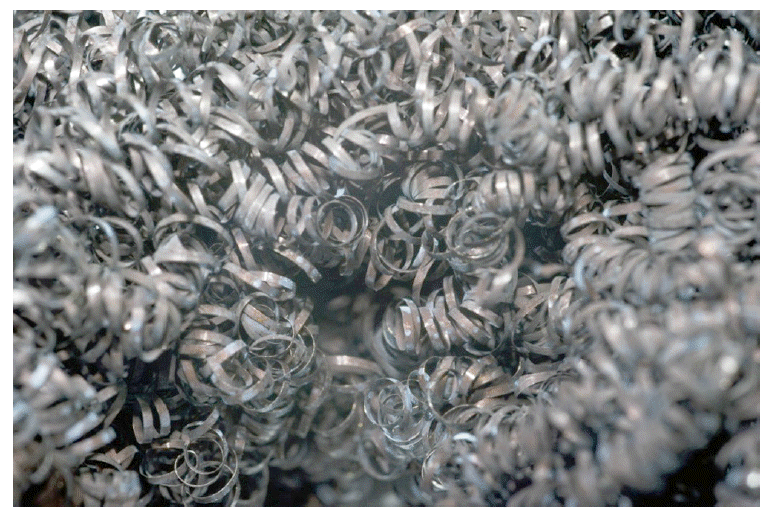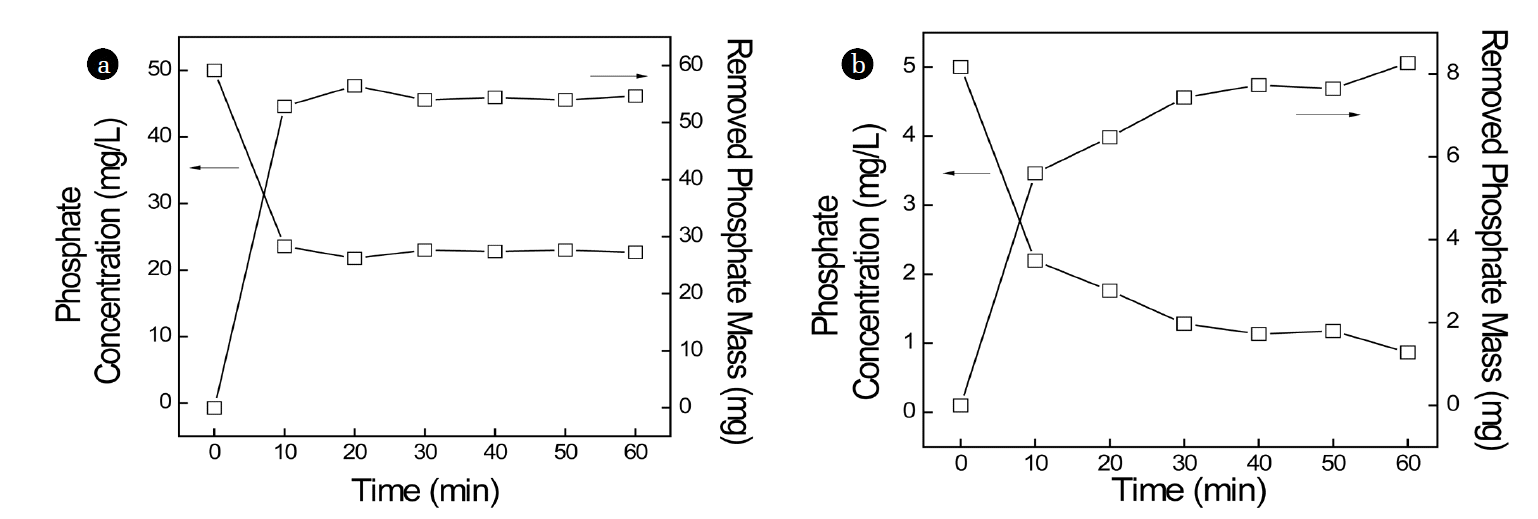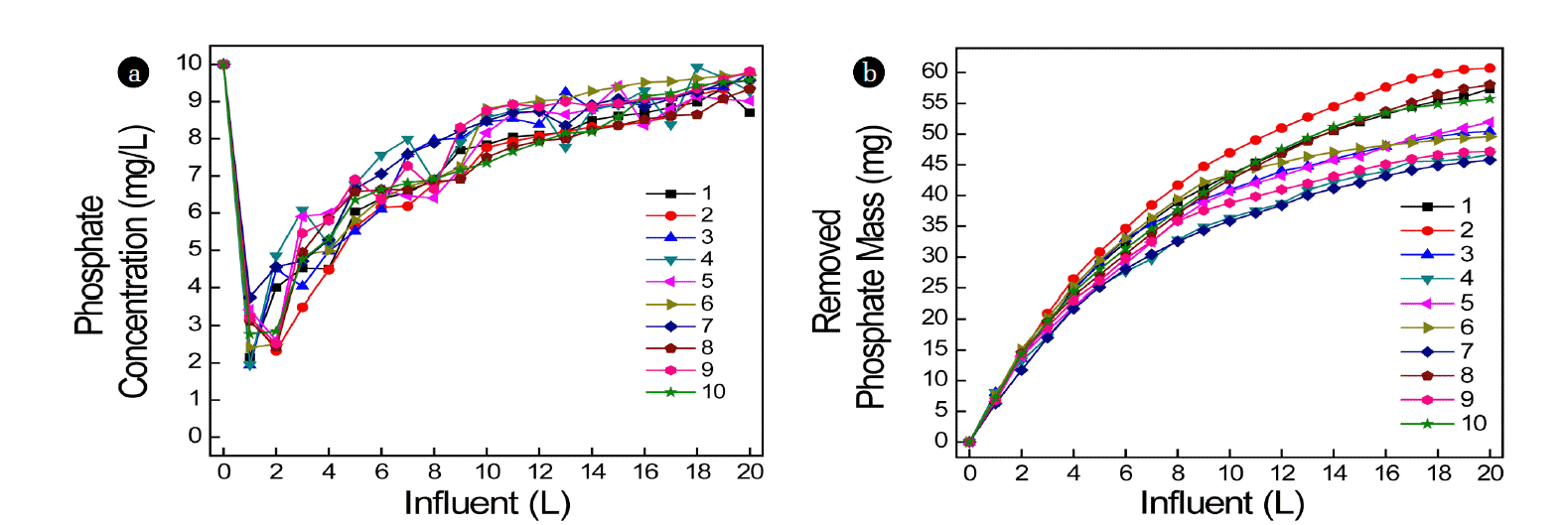1. Introduction
Wastewater is relatively rich in phosphorus compounds, and the phosphorus is a nutrient used by organisms for growth. Phosphates come from a variety of sources including agricultural fertilizers, domestic wastewater, detergents, industrial process wastes and geological formations. Phosphates are classified as orthophosphates, polyphosphates and organic phosphates [1, 2]. The discharge of wastewater containing phosphorus may cause algae growth in quantities sufficient to cause taste and odor problems in drinking water supplies [3–5]. Phosphorus can also interfere with coagulation and with lime soda softening [6]. Dead and decaying algae can cause oxygen depletion problems which in turn can kill fish and other aquatic organisms in streams. For this reason, phosphorus removal is an essential role of wastewater treatment plants and testing for phosphorus in the plant effluent is critical [7].
Biological nutrient removal and chemical precipitation are the most commonly used methods for removal of phosphates in wastewater [8–10], whereas both methods have certain disadvantages. The biological phosphorus removal process requires a highly efficient secondary clarifier and maintenance of sufficient organics concentration. In addition, the main disadvantages in chemical precipitation are higher maintenance cost, problems associated with the handling of chemicals, and the disposal of large amounts of produced sludge. The common and inherent limitation of these two methods is that neither of them can produce an effluent containing less than 0.5 mg/L as P [11, 12].
Therefore, ion exchange and adsorption methods can be a good candidate for phosphorus removal, which is defined as the displacement of one ion by another. To overcome the disadvantages of biological nutrient removal and chemical precipitation methods, an ion exchange and adsorption techniques which are cost effective, easily performed, offers limited sludge production, and has the potential for retained phosphate recycling are needed to remove the phosphate effectively. Concerning phosphate removal through an ion exchange and adsorption method, the use of a filter is more desirable than is an adsorbent. If one is able to selectively remove the phosphorus and to repeatedly use a recycle treatment, it can be a very effective method for advanced wastewater treatment because chemical sludges will not occur and the removed phosphorus can be a useful element as a resource. In addition, there will be no requirement for a large area to set-up a wastewater treatment system. There are other major advantages: low energy consumption, easy upgrading of existing facilities, continuous separation, better effluent quality, and avoidance of any chemical addition. Although there are many kinds of adsorbents for phosphate removal such as activated alumina treated with aluminium sulfate, boehmite, goethite, akaganeite, yttrium carbonate, and polymeric ligand exchanger [13–18], an additional collection process after the phosphate adsorption should be considered. The recycling requirements for these adsorbents should also be addressed.
In our previous research [19], a sintered porous aluminium filter covered by Al(OH)3 through surface modification by alkali treatment and stabilization process was designed for phosphorus removal. Phosphorus in artificial wastewater was removed by ion exchange mechanism from aluminium hydroxide to aluminium phosphate (AlPO4). However, the filter had limitations such as low porosity resulting in severely lower permeability and application of very small amount of artificial wastewater.
In this research, thus, a phosphorus removal filter was fabricated by using a brass scrubber with higher porosity. The brass scrubber was surface-modified to form copper hydroxide (Cu(OH)2) on the surface of the brass, which acts as a phosphate removal filter for advanced wastewater treatment because phosphate ions may be removed by the ion exchange with hydroxyl ions of copper hydroxide. The evaluation of phosphate removal was performed under conditions of an immersion state of the filters in wastewater and a flowing state through filters. Filter recycling was also evaluated with retreatment of the surface modification process.
2. Materials and Methods
2.1. Material
The brass scrubber filter with an average weight of 35 g for each has a flexible porous structure entangled by the coil with a thickness of 40 μm and width of 1 mm, as shown in Fig. 1. This is chemically surface-modified to form a functional surface for the preparation of a phosphorus removal filter. The surface modification process composed of three step, surface oxidation, alkali-treatment, and stabilization, was applied to form the micro-porous surface [20].
The oxidation of the copper surface was performed by boiling in hydrogen peroxide solution of 34% for 30 minutes. The alkali-treatment was subsequently performed by boiling in sodium hydroxide solution of 10 mM for 2 hours. The alkali-treated body was then immersed in boiling distilled water for 30 minutes to stabilize the surface layer after the alkali-treatment. For the recycle of brass scrubber filter, it was re-treated by alkali solution by the same method. The microstructure of the brass scrubber filter was evaluated by scanning electron microscopy (SEM) and transmission electron microscopy (TEM).
Three types of experiments were performed for the evaluation of phosphorus removal performance. The measurement of phosphate was conducted using the ascorbic acid method in the American public health association (APHA) standard methods [21].
2.2. Methods
2.2.1. Batch type experiments using synthetic wastewater
For the evaluation of phosphorus removal by batch type experiments under conditions of various concentrations, synthetic wastewaters with phosphate concentrations of 5 mg/L and 50 mg/L were used. The surface-modified brass scrubber filters, with a weight of 35 g, were immersed in each batch reactor filled with synthetic wastewater of 2 L, and the phosphate concentration in the wastewater was measured at an interval of 10 minutes for 1 hour.
2.2.2. Continuous flow type experiments using synthetic wastewater
Samples with lower phosphate concentrations of 5 mg/L and 10 mg/L, similar to that of typical wastewater, were used in the continuous flow type experiments. The surface-modified brass scrubber filters were stacked in an acryl tube with a diameter of 30 mm, and the wastewater was consecutively sent through the filter stack in the tube. After filtering the wastewater, the brass scrubbers were re-treated by alkali solution using the same method and then filtering was performed once again.
2.2.3. Batch type experiments with typical wastewater
For the performance evaluation of phosphorus removal in typical wastewater, samples with phosphate concentration of 7.3 mg/L were collected from the end of a grit chamber in a small sized wastewater treatment plant in Korea. The biochemical oxygen demand (BOD), total nitrogen (TN) and total phosphorus (TP) of the raw municipal wastewater ranged 110–190 mg/L (average 155 mg/L), 28.0–39.5 mg/L (average 35.5 mg/L), and 2.7–8.2 mg/L (average 7.3 mg/L), respectively. Experimental procedure was performed in the same manner with the batch type experiments using synthetic wastewater as mentioned above.
3. Results and Discussion
Ion exchange, which is defined as the displacement of one ion by another, can be a good candidate for phosphorus removal in wastewater. The displaced ion is originally a part of the insoluble material and the displacing ion is originally in the soluble material. The ion exchange reactions are governed by equilibrium, so that effluents from ion exchange processes never yield pure water. In case of anions, the displacement preferential order for ion exchange can be arranged as follows: SO4−2, CrO4−2, NO3−, AsO4−3, PO4−3, MoO4−2, I−, Br−, Cl−, F−, and OH − [22]. That is, former anions in this sequence can displace the ions coming after them. Thus, the phosphate ion can replace the hydroxide ion which can be formed on the surface of filter. As discussed in a previous study [19], a phosphate removal filter was suggested using porous aluminum, surface-modified to form aluminum hydroxide on the surface. The chemical surface modification treatment gave a unique structure on the surface inducing metal hydroxide.
In this study, the brass scrubber with extremely higher porosity of over 96% was employed for higher permeability. Generally, a highly permeable filter does not guarantee higher filtration efficiency. However, a nanoporous structure on the filter surface revised in this study increases specific surface area which leads to enhanced filtration efficiency.
Fig. 2 shows the surface morphologies of (a) brass, (b) oxidized brass and (c) surface-modified brass. The surface of brass is very smooth. Then, the brass surface was oxidized and became rough by H2O2 treatment as depicted in Fig. 2(b), in which it looks like irregular particulates of several nanometers covered the surface with nanoporous morphology. When the brass was treated in boiling H2O2, oxidation of Cu (Cu+H2O2→CuO+H2O) took place, and then alkali treatment resulted in the reaction of CuO with NaOH as CuO+2NaOH→Na2[Cu(OH)2]. Soluble Na2[Cu(OH)2] salt on the surface is transformed into Cu(OH)2 in the boiling water; Na2[Cu(OH)2]+H2O→Cu(OH)2+2NaOH+H2O. At this point, Cu2+ prefers a square planar coordination with OH −, and this leads to an extended chain that can be connected with each other forming a two-dimensional (2D) structure. Finally, the 2D layers are stacked through the relatively weak hydrogen bond interactions, become a three-dimensional (3D) crystal [23]. This self-assembly can give Cu(OH)2 nanowhiskers. Fig. 2(c) presents the surface morphology of completely treated brass. The copper hydroxide nanowhiskers are grown with a very narrow width of around 20 nm to 100 nm. The nanowhiskers are shaped like corals. This surface structure of the nanowhiskers distribution typically increases the specific surface area by several times.
Fig. 3(a) shows the cross-sectional TEM micrograph of the surface of phosphate filter covered by copper hydroxide. The nanowhiskers of copper hydroxide were grown on the flat surface of brass with a porous structure of which thickness was over 1μm. Near the surface, large nanowhiskers of 200 nm length were grown in a vertical direction to the brass surface, while the small whisker particles aggregated forming a network on the large nanowhiskers which were observed from an overhead view of the filter surface as presented in Fig. 2(c). Fig. 3(b) shows several large nanowhiskers near the brass surface. Their shape looks like a single crystal but several grains are observed in the large whiskers. However, the small whiskers on the large ones were single crystal grains and they were mutually coagulated. Fig. 3(c) presents a high magnification micrograph of the end of a nanowhisker in which the lattice fringe is observed in the vertical direction to the longitudinal direction of the nanowhisker. Such a lattice fringe is revealed to be with 0.2616 nm distance and the longitudinal direction of the nanowhisker is the z direction of orthorhombic copper hydroxide.
The copper hydroxide nanowhiskers formed on the brass surface have many pores so that the surface area is extremely increased. These nanoporous surfaces of Cu(OH)2 supplies a large number of sites for ion exchange with phosphates. The brass coil macro-porous structure has a higher permeability, and such nanoporous surfaces of Cu(OH)2 should have advanced filtration efficiency.
Fig. 4 shows the phosphate removal characteristics of the filter for when it was immersed in the synthetic wastewaters with phosphate concentrations of 50 mg/L and 5 mg/L, as mentioned regarding the first batch type experimental procedure. The phosphate concentration of 50 mg/L dramatically decreased to around 23 mg/L during the first 10 minutes, and then instantly saturated, as shown in Fig. 4(a). The phosphate concentration decreased to around 2 mg/L during the first 10 minutes when the filter was immersed in wastewater with the lower concentrations of 5 mg/L, and it decreased very slowly to about 1 mg/L at 60 minutes as illustrated in Fig. 4(b). The ion exchange site of Cu(OH)2 on the filter surface can easily meet the phosphate ions in wastewater with higher concentrations so that the surface of the filter can change almost completely from Cu(OH)2 to Cu3(PO4)2. Whereas, the phosphate in wastewater with lower concentrations is pressed to find ‘vacant’ Cu(OH)2 sites between previously ion-exchanged Cu3(PO4)2 parts for absorption onto the filter surface. This means that the filtration of wastewater with lower phosphate concentration should require more sufficient contact time for higher removal of phosphate in wastewater.
Fig. 5 and Fig. 6 show the results of the continuous flow type experiments, as mentioned regarding the second experimental procedure. The synthetic wastewaters with phosphate concentrations of 5 mg/L and 10 mg/L were passed through the acryl tube stacked with surface-modified brass scrubber filters for only several seconds. After the first flowing experiments, filters retreated by alkali solution were used for the saturation evaluation of the filter.
As shown in Fig. 5(a), the phosphate concentration rapidly decreased during the first filtering of 1 L, whereas the concentration gradually increased due to saturation of the filter later. When the wastewater of 20 L with a concentration of 5 mg/L was filtered, about 40 mg of phosphate mass was removed, and the removed amount of phosphate was about 40%. The removal also showed similar tendency for the wastewater with a concentration of 10 mg/L. However, rapid saturation was observed and the removed amount of phosphate decreased to about 25% due to the relatively higher phosphate concentration. For both cases, the filtering characteristics were maintained after recycling of used filters.
Fig. 7 shows the phosphate removal characteristics of the filter on a typical wastewater of 10 L with a concentration of about 7 mg/L. For this experiment, wastewater was collected from the end of a grit chamber in a small sized wastewater treatment plant. At the initial filtering, the phosphate concentration decreased to about 2.5 mg/L and gradually increased due to saturation of the filter as with the case of the synthetic wastewater. After filtration, the phosphate concentration was about 4 mg/L and the removal amount of phosphate was over 50%.
Therefore, this filter was very effective in removing phosphate ions from typical wastewater as well as from the synthetic ones, which is a meaningful result, having done so without additional phosphate treatments. The phosphate has various states in typical wastewater, different from synthetic wastewater. The phosphate filtering by ion exchange can be an applicable method for phosphorus removal process because small wastewater treatment facilities generally do not have counter measures for that. The phosphate filtering system can be easily added to a small wastewater treatment facility without change to the original set-up. Also, recycling of used filters was very simple and the extracted phosphate ions could be applied as an industrial resource for synthesis of phosphate compounds.
4. Conclusions
In this study, the possibility of fabricating and recycling a brass scrubber filter through surface modification for phosphate removal was evaluated. The brass scrubber filter was surface-modified to form copper hydroxide on the surface of the brass, which acted as a phosphate removal filter for advanced wastewater treatment because phosphate ions could be removed by the ion exchange with hydroxyl ions of copper hydroxide. The phosphate was rapidly removed within a very shorter contact time by the surface-modified brass scrubber filter, and the phosphate mass of about 1.6 mg was removed per gram of the filter.
The results showed the possibility of this phosphorus removal without undesirable sludge production of existing chemical phosphorus removal techniques. This surface-modified silica filter could be an alternative option for phosphorus removal in small-scale wastewater treatments facilities suffering from unbalanced influent with relatively higher concentration of phosphorus than other components.
















